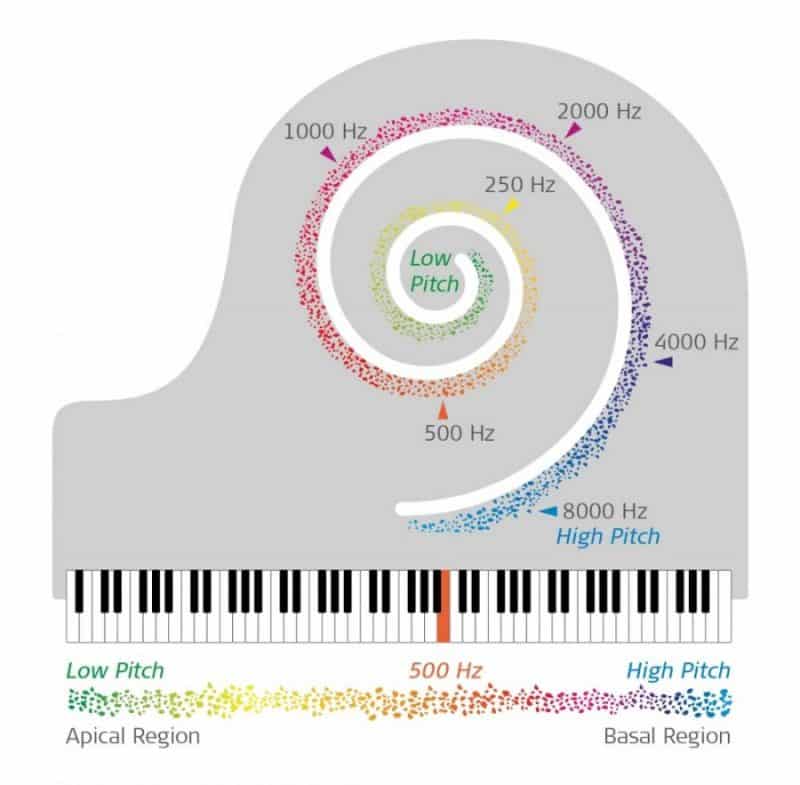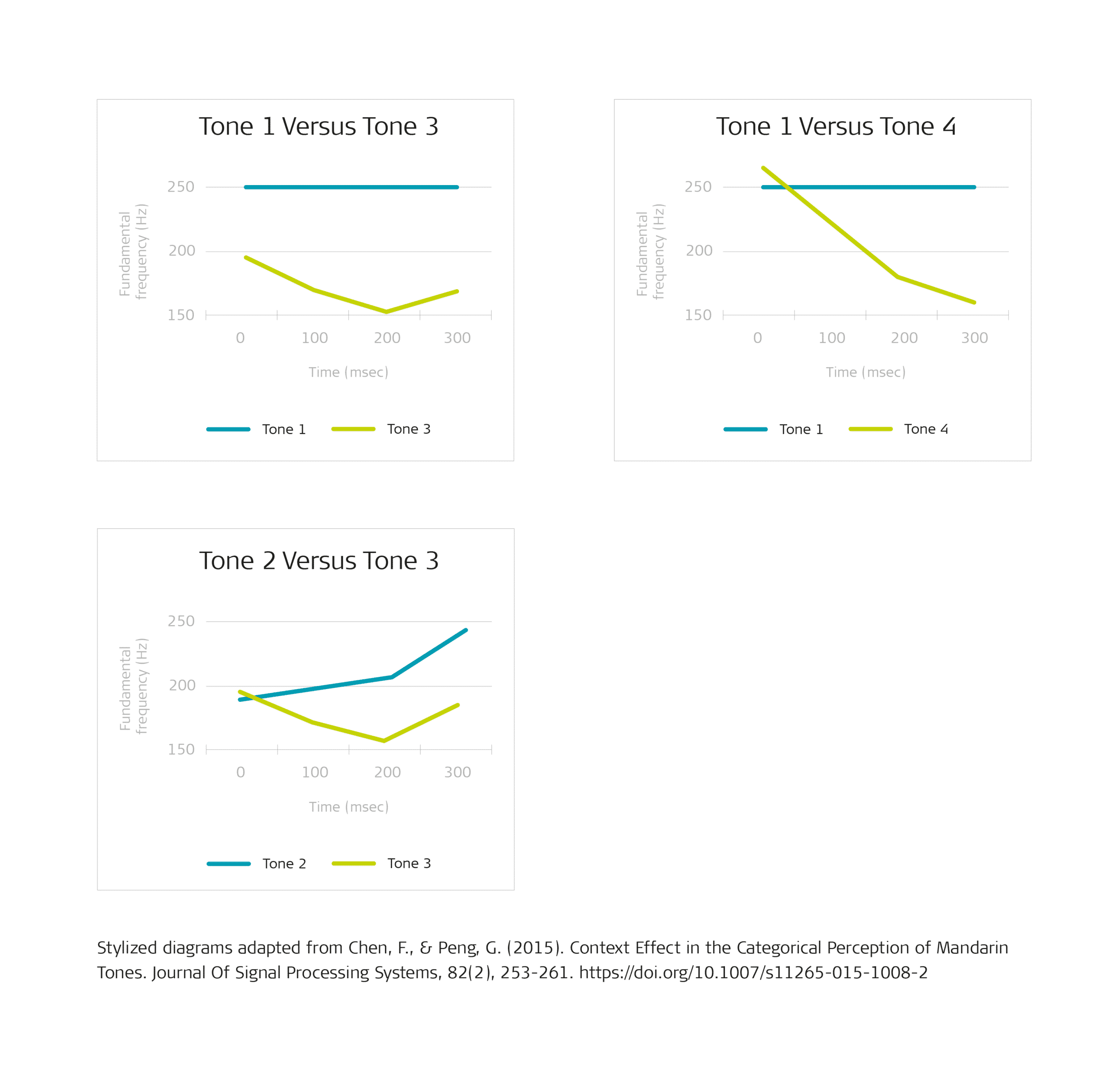Rebecca Claridge, Jia Chuan Lim
Published Apr 15, 2021 | May 22, 2024
Tonal Languages & Cochlear Implants
Nearly half of the global population speaks a tonal language, in which pitch changes can alter the meaning of words. In the last two decades, rapid advances in cochlear implant technology have improved speech perception among these users. Here's the recent research on tonal languages and cochlear implants, along with best practices to facilitate the development of tonal perception and speech production.

70% of the world’s languages are tonal and about half the global population speak a tonal language.Wang, T., & Saffran, J. (2014). Statistical learning of a tonal language: the influence of bilingualism and previous linguistic experience. Frontiers In Psychology, 5. https://doi.org/10.3389/fpsyg.2014.00953[1] In the past, research highlighted the limitations of cochlear implant technology in providing the spectral and temporal cues necessary for listeners to perceive and discriminate tones.Wei, C., Cao, K., & Zeng, F. (2004). Mandarin tone recognition in cochlear-implant subjects. Hearing Research, 197(1-2), 87-95. https://doi.org/10.1016/j.heares.2004.06.002[2] However, more recent studies demonstrate that children learning to listen and speak using cochlear implants can develop good tone perception and production.Shen, Y., Wufuer, Z., Ren, Y., Tang, P., Rattanasone, N., Yuen, I., & Demuth, K. (2020). The production of Mandarin tones by early-implanted children with cochlear implants: effects from the length of implantation. In 10th International Conference on Speech Prosody 2020 (pp. 804-808). https://researchers.mq.edu.au/en/publications/the-production-of-mandarin-tones-by-early-implanted-children-with[3] Research has also shown that adults experience improvements in their ability to perceive tones over the first 12 months of cochlear implant use.Gu, X., Liu, B., Liu, Z., Qi, B., Wang, S., & Dong, R. et al. (2017). A Follow-Up Study on Music and Lexical Tone Perception in Adult Mandarin-Speaking Cochlear Implant Users. Otology & Neurotology, 38(10), e421-e428. https://doi.org/10.1097/mao.0000000000001580[4]
What Are Tones?
Tones are pitch changes that alter the meaning of words. Tones are described by their pitch height and the contour, which is any change in the pitch height over time. Tonal languages can be defined as either lexical or grammatical, or they can be a combination of both.
Lexical tones distinguish words that would otherwise sound the same. For example, the syllable ‘ma’ in Vietnamese can mean ghost, mother, which, tomb, horse or rice seedling depending on the lexical tone.
There are four lexical tones in Mandarin Chinese:
- Tone 1 (high level)
- Tone 2 (mid-rising)
- Tone 3 (mid-falling-rising)
- Tone 4 (high-falling)
These tones are not fixed. They do change at times. For example, when there are two tone 3 in a row, the first tone 3 becomes tone 2.
Grammatical tones carry information about verb tense, the subject, person and other aspects including negation. Grammatical tones are varied and complex. For example, combinations of high, low, mid and rising tones within one word can indicate past, present progressive or future tense on verbs in some African languages.
How Are Tones Perceived With a Cochlear Implant?
Tones are carried on the fundamental frequency (F0) of the voice. Perception of these low frequencies occurs in people with typical hearing in the apexes of the cochleae. Secondary acoustic cues like duration, amplitude contour and spectral envelope of the speech signal are also useful for tone recognition.Xu, L., Zhou, N. (2011). Tonal Languages and Cochlear Implants. In: Zeng, FG., Popper, A., Fay, R. (eds) Auditory Prostheses. Springer Handbook of Auditory Research, vol 39. Springer, New York, NY. https://doi.org/10.1007/978-1-4419-9434-9_14[5]

For cochlear implant users, the selection of a long electrode array that reaches to the apical regions of the cochlear provides a match in both place and pitch for vowel and consonant identification and low frequency stimulation facilitating perception of F0 for tone.
Research has demonstrated that recipients with a long electrode array (31.5 mm) demonstrate better speech recognition than those with a shorter electrode array (24 mm). This was evident immediately following activation and at four years post activation.Canfarotta, M., Dillon, M., Buchman, C., Buss, E., O’Connell, B., & Rooth, M. et al. (2020). Long‐Term Influence of Electrode Array Length on Speech Recognition in Cochlear Implant Users. The Laryngoscope, 131(4), 892-897. https://doi.org/10.1002/lary.28949[6]
Tonal Languages in Children With Typical Hearing
Up until the age of six months all infants with typical hearing are able to distinguish tones. This ability diminishes between six and nine months if the child is not exposed to native tonal language speakers.Mattock, K., & Burnham, D. (2006). Chinese and English Infants’ Tone Perception: Evidence for Perceptual Reorganization. Infancy, 10, 241-265. https://doi.org/doi.org/10.1207/s15327078in1003_3[7]
Discrimination and production of tones with significantly different contours develop early. By 18 months, children learning Mandarin can recognize and produce the difference between tones 1 and 3 and tones 1 and 4.

In contrast, errors in discriminating and producing lexical tones with similar contours (e.g. Mandarin tones 2 and 3) are commonly observed in children between the ages of two and three years.Shi, R., Gao, J., Achim, A., & Li, A. (2017). Perception and Representation of Lexical Tones in Native Mandarin-Learning Infants and Toddlers. Frontiers In Psychology, 8 Art 1117. https://doi.org/10.3389/fpsyg.2017.01117[8]
Facilitating the Development of Tonal Perception and Production
In Children with Cochlear Implants
- Advocate for early implantation with the use of a long electrode array if possible.
- Establish ‘all waking hours’ wear practice for the CI processor(s).
- Immerse the child in a rich spoken language environment to develop a wide vocabulary.
- Create an optimal listening environment and coach families in how to do the same, as noise can affect tone recognition.
- Adopt a developmental approach for all children initially following implantation.
- Consider music lessons with a focus on melodic pitch training.Cheng, X., Liu, Y., Shu, Y., Tao, D., Wang, B., & Yuan, Y. et al. (2018). Music Training Can Improve Music and Speech Perception in Pediatric Mandarin-Speaking Cochlear Implant Users. Trends In Hearing, 22, 233121651875921. https://doi.org/10.1177/2331216518759214[9]
- In addition, adopt a remedial Auditory Training approach for children implanted late or those with a hearing age of more than two years who have not developed discrimination of early developing tones.
In Adults with Cochlear Implants
- A focus on rehabilitation in the first year following implantation may maximize the improvement in perception of tones.Wei, C., Cao, K., & Zeng, F. (2004). Mandarin tone recognition in cochlear-implant subjects. Hearing Research, 197(1-2), 87-95. https://doi.org/10.1016/j.heares.2004.06.002[10]
- Recommend Fine Structure Processing Strategy.Qi, B., Liu, Z., Gu, X., & Liu, B. (2016). Speech recognition outcomes in Mandarin-speaking cochlear implant users with fine structure processing. Acta Oto-Laryngologica, 137(3), 286-292. https://doi.org/10.1080/00016489.2016.1230680[11]
- Recommend the use of a hearing aid in a non-implanted ear.Zhou, Q., Bi, J., Song, H., Gu, X., & Liu, B. (2020). Mandarin lexical tone recognition in bimodal cochlear implant users. International Journal Of Audiology, 59(7), 548-555. https://doi.org/10.1080/14992027.2020.1719437[12]
- Try Auditory Training to improve discrimination of challenging tone contrasts.Wang, S., Liu, B., Zhang, H., Dong, R., Mannell, R., & Newall, P. et al. (2012). Mandarin lexical tone recognition in sensorineural hearing-impaired listeners and cochlear implant users. Acta Oto-Laryngologica, 133(1), 47-54. https://doi.org/10.3109/00016489.2012.705438[13]
- Utilize strategies to increase awareness of and minimize background noise.
- Practice clarification strategies.
This article was written by Rebecca Claridge, Rehabilitation Manager at MED-EL. Thanks to Jia-Chuan Lim, Auditory Verbal Therapist and Rehabilitation Manager at MED-EL Malaysia for her contributions to this article. She is a native Mandarin speaker.
References
-
[1]
Wang, T., & Saffran, J. (2014). Statistical learning of a tonal language: the influence of bilingualism and previous linguistic experience. Frontiers In Psychology, 5. https://doi.org/10.3389/fpsyg.2014.00953
-
[2]
Wei, C., Cao, K., & Zeng, F. (2004). Mandarin tone recognition in cochlear-implant subjects. Hearing Research, 197(1-2), 87-95. https://doi.org/10.1016/j.heares.2004.06.002
-
[3]
Shen, Y., Wufuer, Z., Ren, Y., Tang, P., Rattanasone, N., Yuen, I., & Demuth, K. (2020). The production of Mandarin tones by early-implanted children with cochlear implants: effects from the length of implantation. In 10th International Conference on Speech Prosody 2020 (pp. 804-808). https://researchers.mq.edu.au/en/publications/the-production-of-mandarin-tones-by-early-implanted-children-with
-
[4]
Gu, X., Liu, B., Liu, Z., Qi, B., Wang, S., & Dong, R. et al. (2017). A Follow-Up Study on Music and Lexical Tone Perception in Adult Mandarin-Speaking Cochlear Implant Users. Otology & Neurotology, 38(10), e421-e428. https://doi.org/10.1097/mao.0000000000001580
-
[5]
Xu, L., Zhou, N. (2011). Tonal Languages and Cochlear Implants. In: Zeng, FG., Popper, A., Fay, R. (eds) Auditory Prostheses. Springer Handbook of Auditory Research, vol 39. Springer, New York, NY. https://doi.org/10.1007/978-1-4419-9434-9_14
-
[6]
Canfarotta, M., Dillon, M., Buchman, C., Buss, E., O’Connell, B., & Rooth, M. et al. (2020). Long‐Term Influence of Electrode Array Length on Speech Recognition in Cochlear Implant Users. The Laryngoscope, 131(4), 892-897. https://doi.org/10.1002/lary.28949
-
[7]
Mattock, K., & Burnham, D. (2006). Chinese and English Infants’ Tone Perception: Evidence for Perceptual Reorganization. Infancy, 10, 241-265. https://doi.org/doi.org/10.1207/s15327078in1003_3
-
[8]
Shi, R., Gao, J., Achim, A., & Li, A. (2017). Perception and Representation of Lexical Tones in Native Mandarin-Learning Infants and Toddlers. Frontiers In Psychology, 8 Art 1117. https://doi.org/10.3389/fpsyg.2017.01117
-
[9]
Cheng, X., Liu, Y., Shu, Y., Tao, D., Wang, B., & Yuan, Y. et al. (2018). Music Training Can Improve Music and Speech Perception in Pediatric Mandarin-Speaking Cochlear Implant Users. Trends In Hearing, 22, 233121651875921. https://doi.org/10.1177/2331216518759214
-
[10]
Wei, C., Cao, K., & Zeng, F. (2004). Mandarin tone recognition in cochlear-implant subjects. Hearing Research, 197(1-2), 87-95. https://doi.org/10.1016/j.heares.2004.06.002
-
[11]
Qi, B., Liu, Z., Gu, X., & Liu, B. (2016). Speech recognition outcomes in Mandarin-speaking cochlear implant users with fine structure processing. Acta Oto-Laryngologica, 137(3), 286-292. https://doi.org/10.1080/00016489.2016.1230680
-
[12]
Zhou, Q., Bi, J., Song, H., Gu, X., & Liu, B. (2020). Mandarin lexical tone recognition in bimodal cochlear implant users. International Journal Of Audiology, 59(7), 548-555. https://doi.org/10.1080/14992027.2020.1719437
-
[13]
Wang, S., Liu, B., Zhang, H., Dong, R., Mannell, R., & Newall, P. et al. (2012). Mandarin lexical tone recognition in sensorineural hearing-impaired listeners and cochlear implant users. Acta Oto-Laryngologica, 133(1), 47-54. https://doi.org/10.3109/00016489.2012.705438
References


Rebecca Claridge
Rebecca Claridge is a certified practising Speech Pathologist with more than 30 years’ experience. She certified as a Listening and Spoken Language Specialist in 2008; has worked at the Sydney Cochlear Implant Centre, Brisbane’s Hear and Say Centre and her own private practice. In 2016 she was contracted by MED-EL to create the popular free downloadable resources ‘MED-EL Lesson Kits’ and in 2017 joined MED-EL’s global Rehabilitation Department. In 2021 she moved into a newly created position with MED-EL addressing the rehabilitation needs of Australia, New Zealand and Japan.
Jia Chuan Lim
Jia Chuan Lim (B.Sp.Sc. (HONS), LSLS Cert AVT) is a Speech-Language Therapist and Auditory-Verbal Therapist serving a diverse, multicultural, multilingual community. She is the Rehabilitation Manager for MED-EL Malaysia.
Was this article helpful?
Thanks for your feedback.
Sign up for newsletter below for more.
Thanks for your feedback.
Please leave your message below.
CTA Form Success Message
Send us a message
Field is required
John Doe
Field is required
name@mail.com
Field is required
What do you think?
The content on this website is for general informational purposes only and should not be taken as medical advice. Please contact your doctor or hearing specialist to learn what type of hearing solution is suitable for your specific needs. Not all products, features, or indications shown are approved in all countries.


Rebecca Claridge
Rebecca Claridge is a certified practising Speech Pathologist with more than 30 years’ experience. She certified as a Listening and Spoken Language Specialist in 2008; has worked at the Sydney Cochlear Implant Centre, Brisbane’s Hear and Say Centre and her own private practice. In 2016 she was contracted by MED-EL to create the popular free downloadable resources ‘MED-EL Lesson Kits’ and in 2017 joined MED-EL’s global Rehabilitation Department. In 2021 she moved into a newly created position with MED-EL addressing the rehabilitation needs of Australia, New Zealand and Japan.
Jia Chuan Lim
Jia Chuan Lim (B.Sp.Sc. (HONS), LSLS Cert AVT) is a Speech-Language Therapist and Auditory-Verbal Therapist serving a diverse, multicultural, multilingual community. She is the Rehabilitation Manager for MED-EL Malaysia.

Rebecca Claridge
Rebecca Claridge is a certified practising Speech Pathologist with more than 30 years’ experience. She certified as a Listening and Spoken Language Specialist in 2008; has worked at the Sydney Cochlear Implant Centre, Brisbane’s Hear and Say Centre and her own private practice. In 2016 she was contracted by MED-EL to create the popular free downloadable resources ‘MED-EL Lesson Kits’ and in 2017 joined MED-EL’s global Rehabilitation Department. In 2021 she moved into a newly created position with MED-EL addressing the rehabilitation needs of Australia, New Zealand and Japan.

Jia Chuan Lim
Jia Chuan Lim (B.Sp.Sc. (HONS), LSLS Cert AVT) is a Speech-Language Therapist and Auditory-Verbal Therapist serving a diverse, multicultural, multilingual community. She is the Rehabilitation Manager for MED-EL Malaysia.


